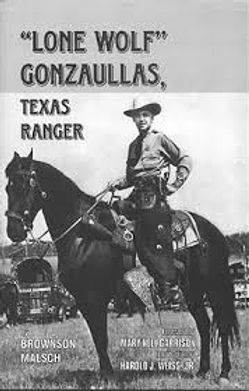

The Lone Ranger tv series ran from Sept 1949, June 1957
The Lone Ranger Disney movie July 2013 >

Who was that masked man? The Lone Ranger, of course - sole survivor of a group of ambushed Texas Rangers, who was nursed back to health by Tonto, his trusty American Indian companion. The pair roam the Old West, defending the helpless against the forces of evil.
The Lone Ranger!
Who was that masked man, The Lone Ranger?

Texas Ranger museum in Waco Texas says it was Lone Wolf Manuel T. Gonzaullas. Gonzaullas (July 4, 1891 – February 13, 1977) was a Texas Rangers captain. He was the son of immigrants, born in Cádiz, Spain. His parents were naturalized American citizens, visiting Spain at the time of his birth, in 1891. In 1940, Gonzaullas was appointment as captain of Company B of the Texas Rangers, thus becoming the first American of Spanish descent to achieve the rank of captain in the force.
He always worked alone, never had a side kick of any sort, never rode a white horse or gave out silver anything to anyone.
After his retirement in 1951, Gonzaullas moved to Hollywood and became a technical consultant for radio, television, and motion pictures, in particular the long-running 1950s radio show Tales of the Texas Rangers. He died of cancer at the age of 85 while living in Dallas, Texas on February 13, 1977, and was buried in Sparkman/Hillcrest Memorial Park in the same city.
But was Gonzaullas “The Lone Ranger”?
If Lone Wolf Manuel T. Gonzaullas
was not The Lone Ranger.
Who was The Lone Ranger?
Well it turns out that "The Lone Ranger wasn't a Texas Ranger at all, but a United States Marshal.

It appears that the real “Lone Ranger” was born to slave parents in 1838 either in Paris, Texas or Crawford County, Arkansas depending upon the source.
This law man was named after his grand father Basse Washington and taking the surname of his owner Reeves, like other slaves of the time. Bass Reeves and his family were slaves of Arkansas farmer & state legislator William Steele Reeves.


Working alongside his parents, Reeves started out as a water boy until he was old enough to become a field hand. When Bass Reeves was eight (about 1846), William Reeves moved to Grayson County, Texas, near Sherman in the Peters Colony.
Bass Reeves was a tall young man, at 6’2”, with good manners and a sense of humor. William Steel Reeves son, Colonel George R. Reeves made Bass Reeves his personal companion and body servant. When Bass was older George Reeves became the Speaker of the House in the Texas legislator (until the time of his death from rabies in 1882). When the Civil War broke out, Texas sided with the Confederacy and George Reeves went into battle, taking Bass with him. During which time Bass parted company with George Reeves and fled to Indian Territory where he took refuge with the Cherokee, Seminole and Creek Indians. While in Indian Territory Reeves honed his firearm skills, becoming very quick and accurate with a pistol.
"Freed” by the Emancipation Proclamation and no longer a fugitive, in 1863 Reeves left Indian Territory and bought land near Van Buren, Arkansas, in 1864 he married Nellie Jennie and started raising a family . (Later in 1900 he married Winnie Sumter.)
Reeves and his family farmed until 1875, when Isaac Parker was appointed federal judge for the Indian Territory. Parker appointed James F. Fagan as U.S. Marshal, directing him to hire 200 deputy U.S. Marshals. Fagan had heard about Reeves, who knew the Indian Territory and could speak several Indian languages. He recruited him as one of his deputies and Reeves was the first black Deputy, West of the Mississippi River.

The deputies were tasked with "cleaning up” Indian Territory and on Judge Parker’s orders, "Bring them in alive --- or dead!" Working among other lawmen Reeves began to ride the Oklahoma range in search of outlaws. Covering some 75,000 square miles, the United States Court at Fort Smith, was the largest in the nation. Depending on the outlaws for whom he was searching, a deputy would generally take with him from Fort Smith, a wagon, a cook and a Native American posse man. Often they rode to Fort Reno, Fort Sill and Anadarko, a round trip of more than 800 miles.
Though Reeves could not read or write it did not curb his effectiveness in bringing back the criminals. Before he headed out, he would have someone read him the warrants and memorize which was which. When asked to produce the warrant, he never failed to pick out the correct one.
Reeves worked for thirty-two years as a Federal peace officer in the Indian Territory. He was one of Judge Parker's most valued deputies. Reeves brought in some of the most dangerous criminals of the time, was never wounded despite having his hat and belt shot off on separate occasions.
An imposing figure, always riding on a large white stallion, Reeves began to earn a reputation for his courage and success at bringing in or killing many desperadoes of the territory. Always wearing a large hat, Reeves was usually a spiffy dresser, with his boots polished to a gleaming shine. He was known for his politeness and courteous manner. However, when the purpose served him, he was a master of disguises and often utilized aliases. Sometimes appearing as a cowboy, farmer, gunslinger, or outlaw, himself, he always wore two Colt pistols, butt forward for a fast draw. Ambidextrous, he rarely missed his mark.
Leaving Fort Smith, often with a pocketful of warrants, Reeves would often return months later herding a number of outlaws charged with crimes ranging from bootlegging to murder. Paid in fees and rewards, he would make a handsome profit, before spending a little time with his family and returning to the range once again.
Reeves became famous among criminals for his skills and relentless pursuit. Although shot at many times, he remained untouched by a single bullet, and because of this he was called “The Indomitable Marshal,” so tough he could “spit on a brick and bust it.”
A newspaper of his times reported, “Place a warrant for arrest in his hands and no circumstance can cause him to deviate.”
In addition to being a marksman with a rifle and pistol, Reeves, during his long career, developed superior detective skills. When he retired in 1907, Reeves claimed to have arrested over 3,000 felons. He is said to have shot and killed fourteen outlaws to defend his own life. Once he had to arrest his own son for murder.
Bass Reeves & The Lone Ranger had similar shooting skills, they both rode a large white horse, both had a Native American helping them in the hunt for outlaws. But it is reported that Reeves gave out silver coins, not silver bullets as the Lone Ranger character gave out. It is also noted that many of the outlaws Reeves captured wound up in Detroit's Federal Prison, with Detroit, Michigan being where the Lone Ranger radio show originated.
Who was The Lone Ranger? Bass Reeves a salve born man. Proof present circumstances don't determine where you can go, it's what you choose do with your life that counts.














